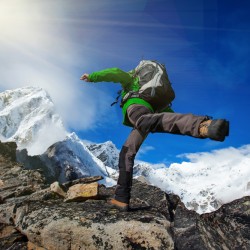When to go to Nepal

When to go to Nepal? This country located in the Himalayas and bordered to the north by China and then surrounding the rest of the country is bordered by India. Nepal is known for their breath taking mountains making it the perfect place for trekkers and hikers looking for a good challenge full of lush greenery and magnificent views.
Trekking in the mountains is the primary reason visitors make their way to Nepal. Of course, Mount Everest, one of the Seven Natural Wonders of the World, is a prized encounter drawing mountain enthusiast to either climb it, trek the area around it, or at least capture a view of it from a scenic flight around the mountain.
When to go to Nepal based on Weather
The majority of Nepal visitors are people hoping to trek in the mountains, therefore they plan their trip almost always based solely on the weather. The country has five major seasons throughout the year including spring, summer, monsoon, autumn and winter. The climate varies depending on where you are in the country and the geographical features surrounding you. For example, in the south summers are tropical and winters are mild while in north summers are cool and winters quite severe.
The best time to go to Nepal
The peak season for Nepal is during autumn, which is late September to late November. The reason for this being the busiest time of the year is that the weather is dry and clear because the monsoons have just come and gone. Temperatures during this time range from 59-75 degrees F. With the pollution and the bugs washed away by the monsoons, it allows for much better visibility, which means that this time is prime for trekking.
Because most people are aware of this, means the trails will be the most crowded and the prices in accommodation will be at their highest. If you are able to either book in advance or don’t mind staying in the best room, this will still be a good time to head to Nepal for some great trekking.
From February to mid-April is the second busiest time of the year because these months mean springtime and warmer weather. With longer days and hills being in full bloom, it is the absolute best time to see some great wildlife.
Best times not to visit Nepal
Just before the monsoons hit, April to early June you can be sure to endure unbearable heat and some rain showers. This is also a very unpopular time to visit Nepal because these weather conditions bring about a much higher likelihood of catching a stomach bug. Chances of you getting some sort of illness are extremely high during this time.
Then comes the monsoon season, which has its many positives and negatives. The flowers and lush greeneries are in full bloom making the country look its absolute most beautiful. However, this means that views of the mountains are limited and leeches are very much present making treks rather miserable. There is also a high chance of flights being cancelled and several road blockages.
When to go to Nepal based on festivals
Dashain Festival: The longest and most anticipated festival throughout the year for Nepal, it lasts 15 days. Depending on the lunar calendar, the festival falls in September or October every year and centers around family gathers and a renewal of community ties. Because it falls during the peak season, it’s perfect for both trekking and being able to celebrate this fun festival.
Tihar Festival: Shortly after Dashain Festival has ended another one begins. Also known as Dipawali, this five-day celebration is a festival full of lights. Worshipping of dogs, cows and the Hindu Goddess of Fortune takes place as well as decorating homes and streets, gift exchanges, flying kites and family meals take place during this time. Once again, if you find yourself in Nepal during the peak season in autumn you have the opportunity to witness and be part of the events that take place during this celebration.

